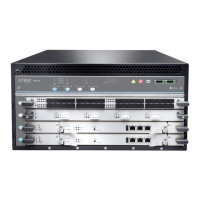•
One copy on the hard disk in the Routing Engine.
•
One copy on a USB flash drive that can be inserted into the slot on the Routing Engine
faceplate.
The Routing Engine boots from the storage media in this order: the USB device (if present),
then the CompactFlash card, then the Solid State Disk (SSD), then the LAN. Normally,
the router boots from the copy of the software on the CompactFlash card.
Related
Documentation
• RJ-45 Connector Pinouts for MX Series Routing Engine AUX and CONSOLE Ports
• RJ-45 Connector Pinouts for an MX Series Routing Engine ETHERNET Port
• Replacing an MX960 Routing Engine
• Supported Routing Engines by Router on page 36
RE-S-X6-64G Routing Engine Description
Figure 18 on page 29 shows the Routing Engine.
Figure 18: RE-S-X6-64G Routing Engine Front View
6—1—
ONLINE/OFFLINE button
Extractor clips
7—2—
SSD LEDs—DISK1 and DISK2Auxiliary port (AUX)
8—3—
Ports—USB1 and USB2Console port (CONSOLE)
9—4—
RESET buttonManagement port (MGMT)
10—5— SSD card slot cover
LEDs—ONLINE, OK/FAIL, and MASTER
•
RE-S-X6-64G Routing Engine Components on page 29
•
RE-S-X6-64G Routing Engine Boot Sequence on page 30
RE-S-X6-64G Routing Engine Components
In routerswith dual Routing Engines, both Routing Enginesmust be RE-S-X6-64G Routing
Engines.
Each RE-S-X6-64G Routing Engine (shown in Figure 18 on page 29) consists of the
following components:
•
CPU—Runs Junos OS to maintain the routing tables and routing protocols.
•
EEPROM—Stores the serial number of the Routing Engine.
29Copyright © 2017, Juniper Networks, Inc.
Chapter 5: Host Subsystem Components and Descriptions

